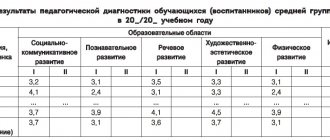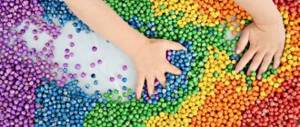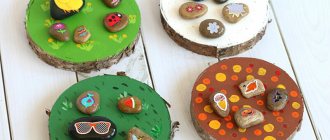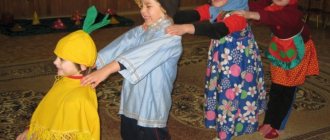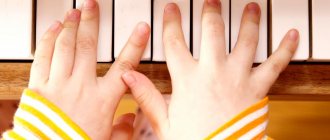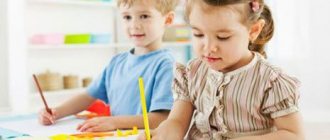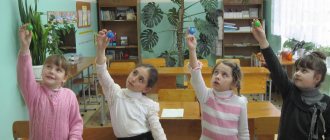Presentation on the topic “Methods of introducing children to the sound structure of words”
By installing the recommended software, you agree to the license agreement for Yandex.Browser and Yandex desktop software.
Advanced training course for 340 rubles!
Emotional burnout of teachers. Prevention and ways to overcome
International distance Olympiads "Erudite III"
Available to all students in grades 1-11 and preschoolers
Record low registration fee
in various subjects of the school curriculum (separate tasks for preschoolers)
We are accepting applications
Description of the presentation by individual slides:
Methods for introducing children to the sound structure of words
In the studies of F.A. Sokhin, L.E. Zhurova and their students, a sequence was developed for the formation of children's orientation in the sound form of a word
Junior and middle groups Learn to pronounce sounds clearly and clearly, listen to the sound of words, distinguish similar and different words by ear, pronounce them with different voice strengths and at different tempos. Children are taught to listen carefully to poems, to rhyming words, and to notice frequently repeated sounds in them. Gradually they learn the meaning of the word sound
Children begin to be introduced to sound analysis in the middle group. This stage is considered as propaedeutic (preparatory) in subsequent training in sound analysis, and then reading. The methodology of working with children of the fifth year of life was studied by N.V. Durova. To solve the problem of preparing children for sound analysis, it is necessary to teach them to perceive a word not as a single sound complex, but as a kind of structural formation consisting of individual sounds, i.e. teach you to hear individual sounds in a word.
Mastering the method of intonation sound identification is helped by techniques of comparing speech sounds with “songs” of their pronunciation, detecting sound (“songs”) in words pronounced by adults (with intonational emphasis of sound). Researchers emphasize that it is necessary to achieve mastery of a generalized method of isolating any sounds in words, and not isolating any specific sound.
Formation of the ability to name an isolated sound and highlight the first sound in a word. For intonational emphasis, children are offered not only hard consonant sounds, but also soft ones: pppetukh (p'), kkkit (k'). The explanation of the softness and hardness of sounds is given in a playful way: paired phonemes (m–m s–s') are called “brothers”; hard phonemes are “angry”, soft ones are “kind” (recommendations by L. E. Zhurova).
Read also
How much do you allow your child to be independent?
Senior group of developing children's ability to perform sound (phoneme) analysis Sound analysis
The method of forming sound analysis was developed by D. B. Elkonin based on the theory of P. Ya. Galperin about the stage-by-stage formation of mental actions. In relation to preschool age, the methodology was adapted by L. E. Zhurova.
Preparatory group for school Children are taught to read based on sound analysis. The operation of sound analysis itself is also being improved. Children perform various tasks in the games “Name the words with the given sound”, “Find your house”, “Who is more attentive”, “Name the words according to the model”, “Chain of words”.
List of sources used Zhurova L. E. Preparing children for modeling the sound composition of a word // Problems of the formation of cognitive abilities in preschool age / Ed. L.A. Wenger. – M., 1980 Sokhin F.A., Tumakova G.A. Familiarization of 5-year-old children with the basic principle of the sound structure of a word // Scientific notes of the Moscow State University of Applied Sciences. – 1970. - Issue 31 Elkonin D. B. Experimental analysis of the initial stage of teaching reading // Questions of psychology of educational activities of schoolchildren. - M., 1962. P.31 Zhurova L. E., Elkonin D. B. On the issue of the formation of phonemic perception in preschool children // Sensory education of preschool children / Ed. A.V. Zaporozhets and A.P. Usova. – M., 1963 Teaching preschool children to read and write. Special course. – M., 1994. – P.17. 394
Add original materials and receive prizes from Infourok
Weekly prize fund 100,000 RUR
By installing the recommended software, you agree to the license agreement for Yandex.Browser and Yandex desktop software.
- Klepova Svetlana Vladimirovna Write 3750 09.19.2017
Material number: DB-694369
International distance Olympiads "Erudite III"
Available to all students in grades 1-11 and preschoolers
Record low registration fee
in various subjects of the school curriculum (separate tasks for preschoolers)
We are accepting applications
By installing the recommended software, you agree to the license agreement for Yandex.Browser and Yandex desktop software.
- 18.09.2017 214
- 18.09.2017 259
- 18.09.2017 296
- 18.09.2017 510
- 18.09.2017 1843
- 18.09.2017 435
- 18.09.2017 185
- 18.09.2017 148
Didn't find what you were looking for?
You might be interested in these courses:
All materials posted on the site were created by the authors of the site or posted by users of the site and are presented on the site for informational purposes only. Copyrights for materials belong to their legal authors. Partial or complete copying of site materials without written permission from the site administration is prohibited! Editorial opinion may be different from those of the authors.
Responsibility for resolving any controversial issues regarding the materials themselves and their contents is taken by the users who posted the material on the site. However, the site’s editors are ready to provide all possible support in resolving any issues related to the work and content of the site. If you notice that materials are being used illegally on this site, please notify the site administration using the feedback form.
INTRODUCTION TO NON-LIVING NATURE
The teacher shows a toy that is well known to the children - a spinner-windmill and asks what makes it spin. Having found out that the pinwheel is rotated by air (wind), the children begin to prepare material for making such a pinwheel. Turntables are made in free time from classes.
Introduction to Magnet
Lesson 1. Introducing a magnet and some of its properties
Goal: to introduce children to a magnet and some of its simplest properties.
Methodological techniques: demonstration, teacher’s explanation, children’s frontal experience; individual work with children; summing up the lesson.
Equipment and materials: for each child on the table - horseshoe-shaped and strip magnets; various small objects - paper clips, pieces of wire (iron, aluminum, copper), scraps of fabric, rubber band, plasticine, paper; two boxes with “Yes” and “No” stickers. On the teacher’s desk there are the same objects and a tripod on which an iron rod is suspended by a thread, and a stack of books.
Progress of the lesson.
Educator.
Children, today I will introduce you to a new subject. This item has a very interesting property - it attracts iron objects to itself. Look, I have an object in my hands. (Demonstrates a strip magnet.) You have the same object on your table. Take it in your hands and examine it carefully. Now put it back in place.
I will show you what properties this item has. I have an iron rod suspended by a thread. (Places a tripod with a suspended rod on the table.) And I will put this object on a stack of books (place a strip magnet on a stack of books so that one end of it protrudes beyond the stack) and I will bring the stack closer to the rod (Fig. 10). Look, the thread with the rod has deviated from its original position. Why did this happen? (Children answer.) Correctly, the thread deviated from its original position because the rod is attracted to the object that lies on the books. Let's call it a magnet.
Now let's see if the magnet always attracts the rod. I will place various objects between the magnet and the rod: a sheet of paper - the rod is attracted; glass - the rod is attracted: book - the rod returns to the equilibrium position. (All this is demonstrated throughout the story.) So, the magnet attracts the rod to itself when it is at a close distance and when there are no other thick objects between it and the rod.
Children, what property does a magnet have? (Children answer.) Does a magnet always attract a rod?
Now take a strip magnet in your hands and, one by one, bring it to the objects that are on your table. Those objects that will be attracted to the magnet, put them in a box with a “Yes” sticker, and if they are not attracted, put them in a box with a “No” sticker. (Children complete the task.)
You have another horseshoe-shaped item on your desk. This is also a magnet, only it has a different shape. It also has the property of attracting certain objects to itself. Let's do the same with this magnet as with the first one. See what objects it attracts and what it doesn't, and put those objects into boxes as you did before. (Children complete the task.)
Children, looking at the boxes, tell which objects the magnet attracts and which ones it does not. (Answers.)
I take a magnet and hold a paper clip to it. She was attracted. I bring a second paper clip to this paper clip. And she was attracted. Now I take the third paperclip, it is attracted to the second (Fig. 11). A chain of paper clips has formed. (The story takes place against the background of the demonstration.) Now I will take the first paperclip with two fingers and carefully remove the magnet. The chain does not fall apart. Who can say why the chain doesn't fall apart? (If the children don’t guess, the teacher prompts.) The paper clips attract each other because while they were next to the magnet, they themselves became magnets. Now do it yourself.
After the preschoolers have completed this experiment, the teacher analyzes the lesson. For analysis, children are asked the following questions: “What did you get to know? What properties does a magnet have? What objects does it attract and what objects does it not attract? Does a magnet always attract iron objects? At the end of the lesson, the teacher summarizes what has been done:
— Today we got acquainted with a magnet and saw that it is metal, iron, and can have different shapes. It has the property of attracting objects to itself. In the next lesson we will learn a lot more new and interesting things about him.
Lesson 2. Introducing a magnet and some of its simplest properties
Purpose: to give an idea of the poles of a magnet
Methodological techniques: demonstration and story by the teacher; children's frontal experience.
Equipment and materials: the same as in the first lesson - iron filings, cardboard or plywood board.
Progress of the lesson
Children are asked to remember what objects are attracted to a magnet. As they repeat, they illustrate their answers with an experiment. Thus, the experiments of the previous lesson are repeated. The experiment with the formation of a chain is repeated separately. It is again confirmed: the chain was formed because the paper clips themselves became magnets (magnetized, have magnetic properties).
The teacher draws attention to the fact that the chain does not last long and breaks up. This is because paper clips are magnetic for only a short period of time. Children are asked to put several paper clips on a board, bring a magnet to the board from below and move it in different directions. They watch how paper clips move along the board following the magnet. The teacher asks to answer why the paper clips move. It is necessary to pay attention to the fact that the action of the magnet on the paper clips occurs through the medium (wood, cardboard).
After the material from the previous lesson has been consolidated in the process of repetition, the teacher begins to explain the new one. The explanation begins with an experiment.
The teacher brings the magnet to the paper clips and shows that they are most attracted to its ends. Children's attention is drawn to the fact that as they move away from the ends, the magnetic properties weaken, and the middle of the magnet does not have attractive properties at all. The teacher invites the children to see this for themselves by moving paper clips to different parts of the magnet.
Children then place the strip magnet on the iron filings. By lifting the magnet, make sure that most of the sawdust is at its edges. Preschoolers conduct the same experiments with a horseshoe magnet.
The teacher pays attention to the color of the magnets. Both bar and horseshoe magnets come in two colors - blue and red. Children are asked to place strip magnets with identically colored ends next to each other. Experience leads them to the conclusion that in this case there will be no attraction. After that, they apply the magnets to each other with ends painted in different colors. Observation makes it possible to state the attraction of differently colored ends to each other.
To generalize the results of the experiment, the teacher performs the following demonstration. The end of a strip magnet of the same color is brought to the end of the magnet suspended on the Tripod. At the same time, children observe repulsion. And then they observe the attraction of differently colored ends to each other. A general conclusion is drawn: differently colored ends attract each other, equally colored ends repel.
Lesson 3. In-depth repetition of previously learned. Introduction to the compass. Determining cardinal directions using a compass
Purpose: 1) consolidate the information received about the magnet and its properties; 2) familiarize children with the compass, teach them to determine the cardinal directions using a compass.
Equipment: all materials from previous classes. A glass glass half filled with water. Demonstration magnetic needle on a stand, small magnetic needle on a stand, compass.
Progress of the lesson
Children, at the request of the teacher, remember what objects the magnet attracts. Familiar experiments are carried out, once again emphasizing that a magnet exhibits its magnetic properties most strongly at the ends.
The teacher takes a glass of water and throws two nails into the water. The children are given a task: to pull out the carnations without getting their fingers and the magnet wet. With guiding questions, the teacher leads them to the correct solution: you can pull out the carnations using a magnet. Children practice pulling iron objects out of water with a magnet (Fig. 12). The teacher leads them to the conclusion that magnetic properties manifest themselves not only in air, but also in water and glass.
Then the teacher sets up a tripod on his desk with a strip magnet suspended on a thread. Draws attention to the position of the ends of the magnet: the red end is directed towards some landmark in the room, the blue end towards another. The magnet is released from rest, but after some rotation it is restored to its original position. This demonstration is done several times, focusing on the fact that the magnet, after stopping, always has its ends in a certain direction. The attention of preschoolers is drawn to the fact that the red end of the magnet points to the sunny side, to the south, and the blue end to the north.
The teacher repeats the experiment with a suspended magnet. No matter how you turn the magnet, it is always installed in such a way that one end points to the south and the other to the north. If you go in the direction of the red end of the magnet, then the movement will occur only to the south, in the opposite direction - only to the north. Having such a suspended magnet with you, you can find out in any conditions where is south and where is north. Since hanging a magnet is inconvenient, it is made in the form of an arrow and the arrow is placed on a needle. The teacher demonstrates the arrow on the stand. Its ends, like those of a suspended magnet, point south and north. The small magnetic needle on children's tables behaves in exactly the same way.
You can take an even smaller arrow and place it on the needle in the box. Such a box with a magnetic needle is called a compass. Children are asked to look at the compass and make sure that the needle in the compass is magnetic. To do this, carefully bring a strip magnet to the end of the arrow and notice that it is attracted or repelled, depending on which end of the magnet is approached.
Using a compass, they determine where is south and where is north, paying attention to the letters written on the compass dial. They explain that the letter “Y” means south, the letter “S” means north, “3” means west, and “B” means east. After this, children are taught to determine the cardinal directions using a compass. The teacher suggests placing a wooden stick on the glass of the compass so that it connects the letters “3” and - “B”. Then, he explains, you need to carefully turn the compass until the red end of the arrow coincides with the letter “Y”. Now the arrow shows the direction north - south, and the stick lying on the glass shows the direction west - east. Children orient the compass and show with their hand the direction to the south, north, west, east.
The teacher calls the children one by one and checks their ability to use a compass. To do this, they are asked to perform a number of exercises, for example: orient the compass, show where north, south, east, west are; walk west, holding a compass in your hands, three steps, and now five steps south, etc.
On one of the following days, in order to develop the ability to navigate the terrain and develop skills in determining the cardinal directions, a didactic game “North, South, East, West” is held at the site, all children of the group participate in it.
Before the game starts, the teacher buries a box with some toys or objects shallowly in the ground and outlines the routes of movement and the starting positions of the units. All this work is carried out in the absence of children.
Then all children are given compasses. The group is divided into squads (there can be from 2 to 4), and senior leaders are appointed. Seniors are given shovels. Then the conditions of the game are announced: each squad follows the route indicated by the teacher. At the end of the route, the squad leader, if the squad walked correctly, will find the hidden object. As an example, we give one of the possible routes of detachments (Fig. 13). The 1st detachment follows the route: 10 steps to the west, 10 steps to the south, 6 steps to the east; 2nd squad: 10 steps to the east, 4 steps to the south, 8 steps to the west; 3rd squad: 10 steps north, 8 steps west, 5 steps south. As can be seen from the route diagram, if the game conditions are followed correctly, everyone should come to one place.
As the game is repeated, the routes become more complex due to the introduction of new directions.
Light. Straightness of its distribution .
Familiarization with light takes place in the form of a game. In sunny weather, in the garden area, children are invited to play the following game. Each player needs to step on his partner's shadow and at the same time prevent his partner from stepping on his shadow. The game is played in the morning, afternoon and evening. This is necessary so that children can conclude that the shadow is short during the day, and long in the morning and evening. While playing, children become convinced that a shadow accompanies a person or object under any conditions. But the size of the shadow of the same object changes throughout the day. The teacher draws attention to the fact that all objects have a shadow.
After the walk, the teacher explains what a shadow is, accompanied by a demonstration. Having positioned the table lamp so that the light from it is directed towards one of the walls of the room, he places various opaque objects between the lamp and the wall. Children's attention is drawn to the fact that the shadow always has the configuration of the object from which it is received; its dimensions depend on the location of the object between the lamp and the wall. Opaque objects of any color have a shadow of the same color. The teacher makes a drawing on the board (Fig. 14) and explains that the light comes from the lamp in rays. These rays are delayed (do not pass through) by an opaque object, and behind it a place is formed where the rays do not reach. The place where the rays do not fall is called the shadow.
The explanation ends with the game. Children use their palms and fingers to create various shadows on the wall of the room. With the help of a teacher, this game can turn into an improvised shadow theater.
Further familiarization is again transferred to the garden area. Children are given mirrors and taught to catch and direct sunbeams in the right direction. The teacher explains how bunnies are formed: the sun's rays hit the mirror and are reflected from it.
Next time this activity game will be more difficult. Children are explained and shown that a bunny can only be caught by pointing a mirror towards the sun. Since the garden area is mainly located on the south side of the building, it is very difficult, and sometimes simply impossible, to get reflection in the group room. The teacher helps to cope with the task.
At the site, one child stands with his back to the window and facing the sun, the other - facing the window and with his back to the sun. The first catches the bunny and directs it into the mirror of the other, and the second directs the bunny out the window (Fig. 15). The task can be complicated by involving three or more children in solving it.
Then the children must make drawings and show the path of the rays in them. The main thing here is the formation of the idea of light as rectilinearly propagating rays.
Introduction to thermal phenomena
If at an earlier age children were taught to distinguish between solid objects and liquids, then in the older group it is quite possible to impart knowledge of how the transition from one state to another occurs (from solid to liquid, from liquid to vapor, and vice versa).
The main task is to form in children an idea of the universality of these phenomena: all solids can be turned into liquid, all liquids can be turned into steam. Familiarization is carried out both in classes and on walks and in conversations. Lesson notes are not provided here; only a general description of what and how to introduce children to is given.
The task is, as already noted, to show the child that all substances can be in three states of aggregation: solid, liquid and gaseous. Classes on this topic are held in winter.
The teacher takes a piece of ice and asks the children what can be said about it. Children will answer that the ice is cold, point to its color, and tell that the ice can melt. They touch the ice and say it is hard. What other solids do they know? Do they look like ice? Children will most likely answer that they are not similar, since ice melts, but other bodies do not, they remain solid all the time.
The teacher shows that ice has properties that other solids also have: a piece of brick is hard,” when hit with a hammer, it breaks into small pieces; the ice also breaks upon impact. The wire is hard, but can be bent. The same can be done with ice. For this purpose, take a large, but not thick piece of ice (a large icicle), place one end on a stool and press it with a hard object. Hang something heavy on the other end of the rope. After a few hours the icicle will bend. (This experiment is carried out outdoors.) Conclude: ice is a solid body, it can be bent.
Coming from a walk, the teacher or children put a piece of ice on a plate, and after a while it will melt (melt). Solid ice turned into water. Why did this happen? After all, the ice on the street would not turn into water. The children will answer that the room is warm, so the ice has melted; This means that ice melts when it heats up. Water, when cooled, turns into ice.
For the experiment, take vessels with water, paint the water in different colors, pour the colored water into molds and place them on the balcony or windowsill. After some time, the water freezes, creating pieces of multi-colored ice. Conclusion: Water can become a solid (ice) when cooled, and ice can become a liquid (water) when heated. But there are many other solids. Can other bodies turn into liquid? Maybe this is unique to ice?
A piece of sugar is hard and, like ice, can be broken with a hammer. But can it turn into a liquid if heated, like ice? Sugar is placed in a spoon and heated over a fire, it melts, becomes liquid, and can be poured. You need to pour the liquid sugar into another spoon, and after a while it will harden, forming a hard candy. If the contents of the spoon are poured into a mold specially prepared for this, the candy can be given a wide variety of shapes (cockerel, star, etc.).
You can do the experiment with wax. It heats up in your hand and becomes soft. You can melt it over a fire, pour the melted wax into some form. The hardened wax takes the shape of a vessel.
This demonstrates some of the properties of bodies in nature and their transformations under the influence of heat.
The proposed content of knowledge about inanimate nature is approximate, but it is necessary to talk about the phenomena considered with children of senior preschool age. An indispensable condition for the implementation of the methodological recommendations proposed by the author should be the independent solution by children of feasible problem problems, an active analysis of the mistakes made in solving these problems. Everything that a child learns should give him the opportunity to apply this knowledge in other areas of communication with living and inanimate nature.
back next
We carry out various experiments
In the cold season, when there is snow outside the window, children can be introduced to nature in kindergarten based on the changing consistencies of water. For example, put a saucer with it outside the window, and after a while discuss with the children why a crust of ice appeared. Or, on the contrary, put snow in a container and observe how it changes its state of aggregation.
Any materials can be used for experiments. For example, put sand and clay in jars and pour in the same amount of water. Note that the liquid passed through the sand, but not in the case of clay. Also invite the children to “bake pies” from dry and wet sand, and generally diversify their leisure time by playing with sand in a variety of ways.
It is necessary to explain to children that plants feel better on the sunny side and in warmth than in the shade. But don’t forget to mention that plants have different “predilections” for water and light, moisture and additional fertilizers. You can take the seeds of a quickly germinating crop, put them in a damp cloth and store them in different conditions. Obviously, in warm conditions the plant will sprout much faster.
Introducing children to nature in kindergarten can be done in a variety of forms. The teacher must choose the most interesting and educational ones and present them as simply as possible. Tell the kids not only about nature, but also about the human body, existing senses and sensory organs, about the benefits of different animals for nature and our lives (bees bring honey, a cat catches mice, a chicken lays eggs, etc.).
You can come up with new activities and games every day. Recommend that some children study in depth the development of certain skills at home. Perhaps one of the parents should be suggested to visit a speech therapist, psychologist, or orthopedist. Or just work on your hand motor skills and pronunciation of sounds at home.
